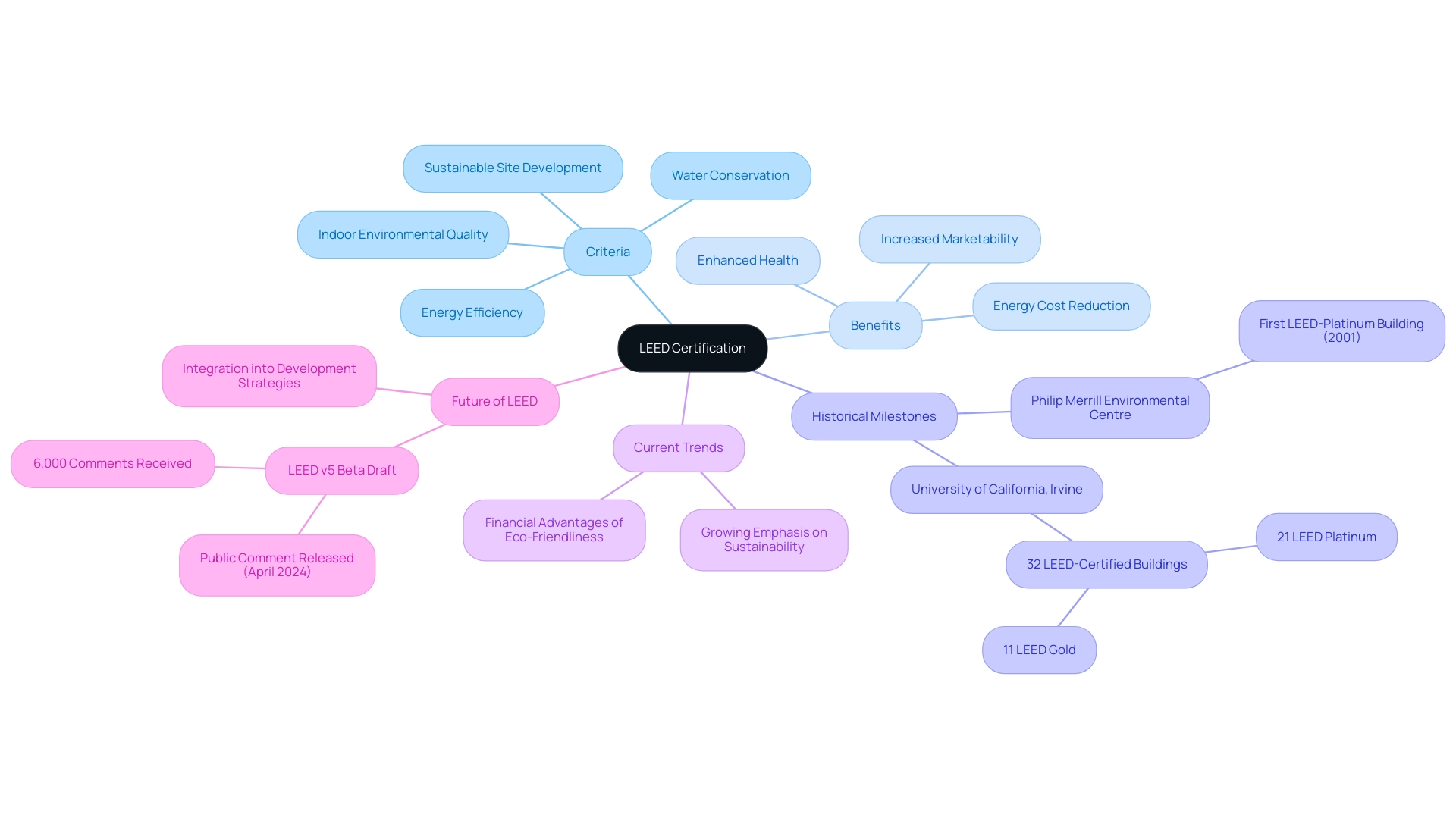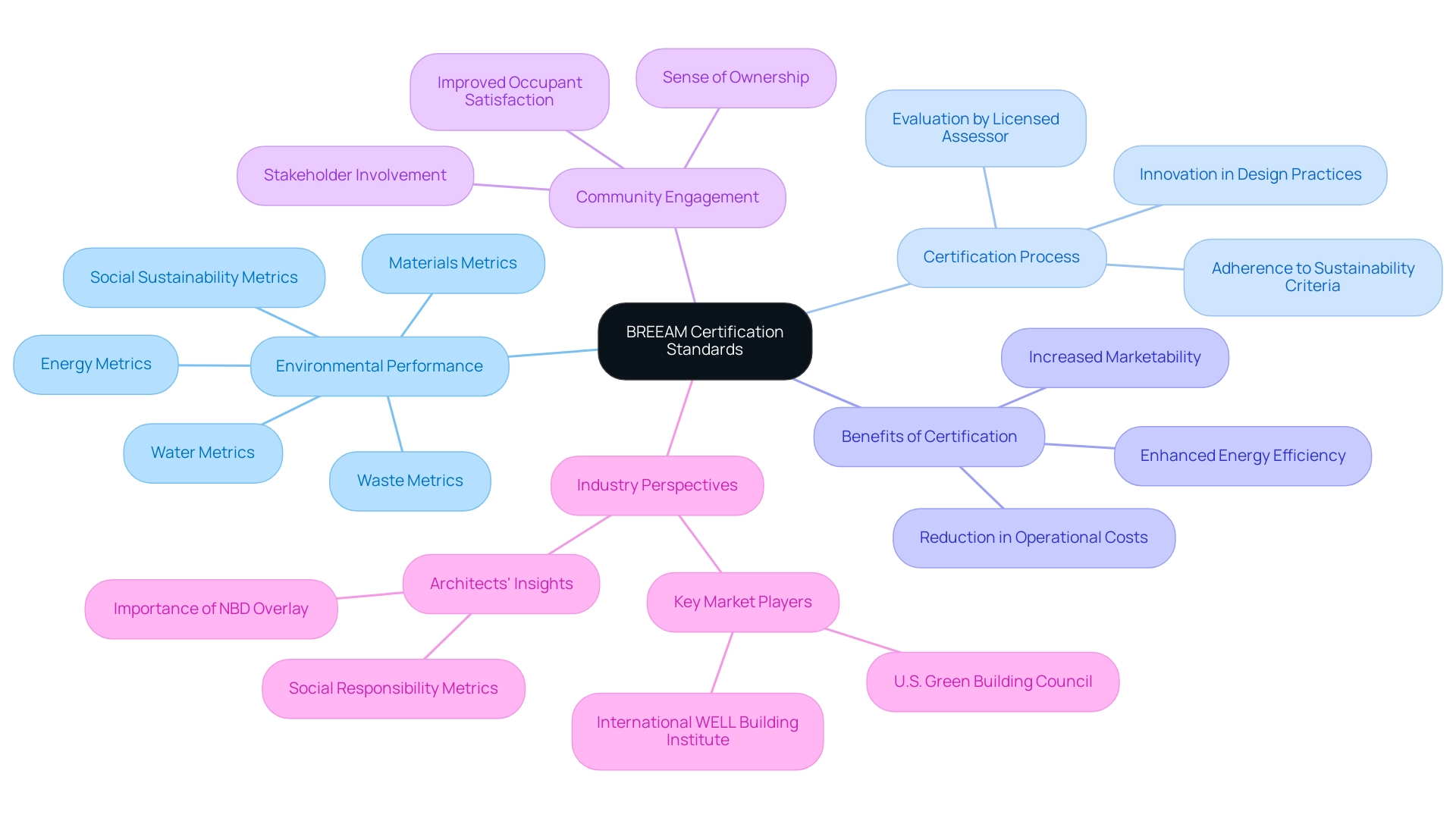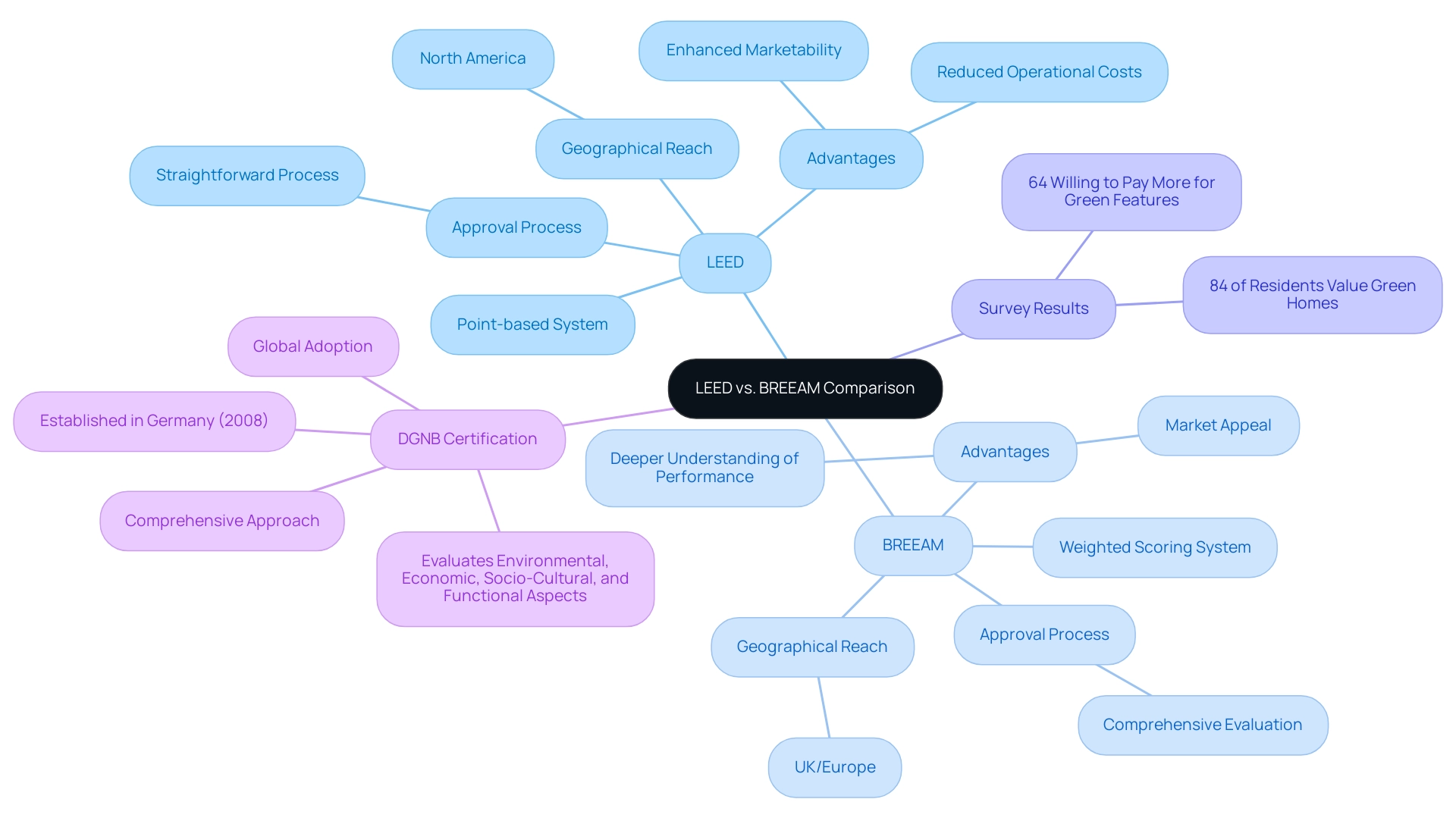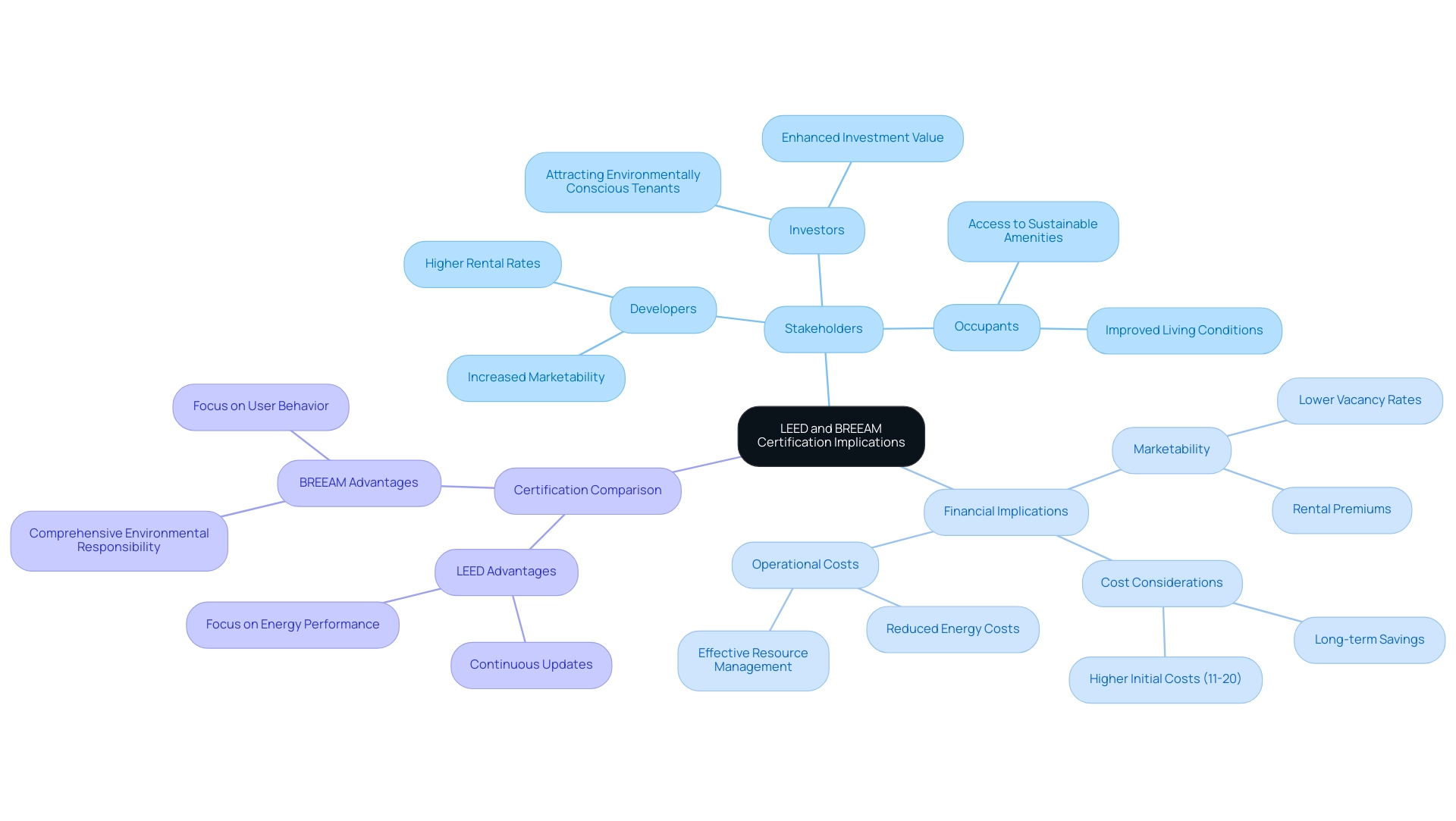27 Mar 2025
BlogOverview
This article provides a comprehensive comparative analysis of LEED and BREEAM certification standards, underscoring their critical roles in advancing building sustainability through distinct methodologies and criteria. Both certifications not only enhance marketability but also significantly reduce operational costs.
- LEED, primarily recognized in North America, utilises a point-based system.
- BREEAM, prevalent in the UK and Europe, employs a more nuanced weighted scoring system.
This divergence reflects their geographical and procedural differences, highlighting the unique approaches each certification takes in promoting eco-friendly practices.
Introduction
In a world increasingly focused on environmental responsibility, sustainable building design has emerged as a vital aspect of the construction industry. This approach, grounded in principles of energy efficiency, water conservation, and the use of sustainable materials, not only minimises ecological impact but also enhances resource management.
As the demand for sustainable practices intensifies, certifications like LEED and BREEAM play pivotal roles in guiding developers and architects toward greener solutions. By examining the trends, benefits, and implications of these certifications, stakeholders can better navigate the complexities of sustainable construction.
Ultimately, this contributes to a healthier planet and improved living conditions, prompting action towards a more sustainable future.
Understanding Sustainable Building Design
Building sustainability in design is centred on minimising environmental impact while maximising resource efficiency. The key principles of building sustainability, energy efficiency, water conservation, and the use of eco-friendly materials, are essential to the creation of certification standards like LEED and BREEAM, which aim to promote building sustainability within the construction industry.
In 2025, the emphasis on eco-friendly building design is more pronounced than ever, with 71% of projects valued at £50 million and above referencing LEED in their specifications. This statistic underscores the growing recognition of environmental responsibility as a critical factor in project planning and execution, directly influencing how firms like Edmond Shipway approach their consultancy services.
Moreover, a significant 40.6% of industry professionals regard resource efficiency as vital for building sustainability, reflecting a commitment to responsible material use in eco-friendly designs. This aligns seamlessly with Edmond Shipway’s sustainability consultancy, which focuses on helping clients adopt practices that enhance resource management and reduce environmental footprints across various sectors, including hospitality and healthcare.
The impact of eco-friendly building design on building sustainability transcends mere compliance with regulations; it enhances marketability and reduces operational costs over time. Current trends indicate a robust shift towards energy-efficient solutions, emphasising the role of building sustainability.
Expert opinions highlight that incorporating eco-friendly design principles not only meets client needs but also plays a crucial role in building sustainability and aligning with broader societal objectives. Theories such as the Diffusion of Innovation and the Theory of Planned Behaviour suggest a positive correlation between awareness and the adoption of eco-friendly practices. As stakeholders become more informed, they are more likely to implement these principles effectively. Edmond Shipway is pivotal in promoting these practices among clients, ensuring they are equipped to navigate the complexities of sustainable construction.
Economic factors, client demands, and individual dedication to environmental responsibility are critical influences on these practices. This variability emphasises the necessity for ongoing education and advocacy within the industry to foster a culture of sustainability, a challenge that Edmond Shipway is well-positioned to address.
Ultimately, comprehending and applying these key principles of eco-friendly design is essential for stakeholders seeking to navigate the complexities of building sustainability. By prioritising energy efficiency and resource management, the construction industry can significantly reduce its environmental impact, thus playing a vital role in building sustainability for a more eco-friendly future.
Exploring LEED Certification: Criteria and Benefits
LEED (Leadership in Energy and Environmental Design) stands as a premier global accreditation system, rigorously evaluating buildings for sustainability against a comprehensive set of criteria. These criteria include:
- Energy efficiency
- Water conservation
- Indoor environmental quality
- Sustainable site development
The benefits of achieving LEED recognition are substantial; they encompass significant reductions in energy costs, enhanced occupant health, and increased property marketability.
Notably, LEED-certified structures frequently command higher rental rates and experience lower vacancy rates, rendering them particularly attractive to developers and investors.
The approval process is thorough, involving a meticulous assessment that ensures projects comply with stringent sustainability standards. For instance, the University of California, Irvine exemplifies a commitment to eco-friendly construction methods, boasting 32 LEED-certified structures, including 21 that have achieved the prestigious LEED Platinum certification. This not only underscores the university’s dedication to sustainability but also illustrates the tangible advantages of sustainable design in educational environments.
Current trends indicate a growing emphasis on building sustainability through LEED accreditation among builders in 2025, driven by increased awareness of the financial advantages of eco-friendliness. Properties that meet LEED standards are not only more energy-efficient but also foster a healthier living environment, a quality increasingly valued by tenants and buyers alike. Furthermore, the beta draft of LEED v5, released for public comment in April 2024, reflects ongoing advancements in sustainability practices, with nearly 6,000 comments received, showcasing robust industry engagement.
The evolution of LEED credentials continues to inspire developers to prioritise sustainability in their projects. This perspective reinforces the necessity of integrating LEED standards into structure management and development strategies.
In summary, the financial and environmental benefits of LEED certification are unmistakable. As developers strive to enhance their portfolios, building sustainability through the incorporation of LEED standards into management and development strategies will remain pivotal in shaping the future of sustainable construction.

An Overview of BREEAM Certification Standards
BREEAM (Building Research Establishment Environmental Assessment Method) stands as the foremost assessment framework for environmental performance in master planning projects, infrastructure, and buildings globally. It plays a pivotal role in recognising and enhancing the value of high-performing assets throughout the lifecycle of the built environment, especially concerning building sustainability from new construction to refurbishment and ongoing use. In 2025, BREEAM continues to evolve, incorporating updated standards that reflect an increasing emphasis on social sustainability metrics alongside traditional environmental performance categories such as energy, water, materials, and waste.
The certification process is rigorous, involving a thorough evaluation by a licensed BREEAM assessor who ensures that projects adhere to stringent sustainability criteria. This meticulous approach not only guarantees compliance but also fosters innovation in building sustainability design practices. BREEAM-certified structures are linked to numerous advantages, including enhanced energy efficiency that can lead to significant reductions in operational costs. Furthermore, these structures typically enjoy increased marketability, appealing to environmentally conscious investors and tenants alike.
Recent statistics reveal that BREEAM certification is increasingly sought after, with a notable rise in projects achieving certification across various sectors, including hospitality. Successful projects utilising BREEAM standards illustrate the tangible benefits of building sustainability through eco-friendly practices. For example, a case study on community engagement in eco-friendly building design emphasises how involving local stakeholders in the decision-making process can lead to designs that enhance building sustainability while also meeting environmental goals, thereby improving social cohesion and occupant satisfaction.
This aligns with findings that community-based design approaches not only improve occupant satisfaction but also foster a sense of ownership among residents. In 2025, the advantages of BREEAM certification for developers are more pronounced than ever. Developers can leverage BREEAM’s reputation to distinguish their projects in a competitive market, while also contributing to a more environmentally friendly future. Insights from industry experts indicate that over 80% of architects recognise the importance of integrating social responsibility metrics into BREEAM standards, underscoring the framework’s significance in promoting eco-friendly practices essential for building sustainability.
Edmond Shipway’s expertise in project management and cost consultancy uniquely positions the firm to assist developers in effectively navigating the BREEAM approval process. By leveraging its extensive experience, Edmond Shipway can guide clients in adopting environmentally friendly practices that align with BREEAM standards, thereby ensuring projects not only meet certification requirements but also achieve excellence in ecological responsibility.
As the construction environment continues to evolve, BREEAM remains an essential tool for developers striving for excellence in eco-friendliness.

Comparative Analysis of LEED and BREEAM: Similarities and Differences
LEED and BREEAM play crucial roles in advancing building sustainability practices, yet they exhibit distinct methodologies and criteria. LEED operates on a point-based system, allowing projects to accumulate points by meeting specific environmental criteria. Conversely, BREEAM employs a weighted scoring system that reflects a more nuanced approach to evaluation, assigning varying levels of importance to different building sustainability issues.
Regionally, LEED is predominantly recognised in North America, while BREEAM has a stronger foothold in the UK and Europe. This geographical distinction is particularly relevant for hospitality developers operating in these markets, influencing their choice of accreditation. Developers often align their projects with the standards that are most pertinent to their location. Moreover, the approval process for LEED is generally perceived as more straightforward, making it accessible for a broader range of projects.
On the other hand, BREEAM’s assessment necessitates a comprehensive evaluation by trained assessors, which can yield a deeper understanding of building sustainability performance. The approval process and adapting a project to the guidelines is time-consuming and is often linked to increased financial outlays.
Both qualifications offer substantial advantages, such as enhanced marketability and reduced operational costs. A recent survey indicates that 84% of residents prioritise living in green homes, with 64% willing to pay a premium for green community features. This growing demand underscores the significance of eco-friendly certifications in building sustainability, as they attract potential buyers and tenants.
In terms of outcomes, both LEED and BREEAM have proven effective in promoting building sustainability. The DGNB certification system, established in Germany, serves as a complementary example, evaluating structures based on environmental, economic, socio-cultural, and functional aspects. Its adoption across various nations has resulted in enhanced building performance and eco-friendliness, illustrating the global transition towards comprehensive environmental planning.
Ultimately, the decision between LEED and BREEAM often hinges on the project’s location and specific building sustainability objectives. By understanding the nuances of each credential, developers can make informed choices that align with their goals and the expectations of their stakeholders.

Implications of LEED and BREEAM Certification for Stakeholders
The adoption of LEED or BREEAM credentials can profoundly impact project outcomes for a diverse range of stakeholders, including developers, investors, and occupants, thereby enhancing building sustainability. Structures that prioritise sustainability often enjoy increased marketability, which translates into higher rental rates and lower vacancy rates. Research indicates that properties with eco-friendly designations can command rental premiums of up to 20%, reflecting the growing demand for sustainable practices in real estate.
However, it is critical to recognise that 38% of builders have reported that green building costs 11-20% more than standard construction, highlighting the financial considerations inherent in building sustainability. Additionally, these buildings typically benefit from reduced operational costs, attributed to improved energy efficiency and effective resource management. For investors, acquiring such endorsements serves as a clear indication of a commitment to sustainability, attracting environmentally conscious tenants and enhancing the overall value of the investment. As environmental regulations become increasingly stringent, possessing a recognised qualification not only ensures compliance but also plays a pivotal role in sustainability by mitigating risks associated with potential non-compliance.
The decision between LEED and BREEAM should be strategically aligned with the project’s objectives, geographical context, and stakeholder expectations. Both credentialing systems offer distinct advantages; for instance, LEED’s continuous updates aim to enhance energy performance forecasts, whereas BREEAM emphasises sustainability through a comprehensive approach to environmental responsibility. Ongoing improvements to LEED versions address issues related to user behaviour and operational conditions, which are essential for achieving the desired environmental outcomes.
Case studies illustrate the tangible benefits of accreditation, emphasising how effective communication of eco-friendly initiatives can meet client expectations and provide a competitive edge in securing new projects. As the construction sector continues to evolve, the financial implications of LEED and BREEAM credentials will remain a crucial consideration for stakeholders aiming to enhance sustainability and capitalise on the burgeoning market for sustainable structures.
Furthermore, as noted by L.M.L.R., the USGBC, the organisation behind LEED, regularly updates its standards based on stakeholder feedback, demonstrating a commitment to sustainability and aligning the accreditation with global sustainability targets. This adaptability is vital for maintaining the relevance and effectiveness of certification standards in an industry that is rapidly changing.

Conclusion
Sustainable building design is not merely a trend; it is an essential requirement for the future of the construction industry. The principles of energy efficiency, water conservation, and the utilisation of sustainable materials form the bedrock of creating structures that minimise environmental impact and enhance resource efficiency. As emphasised throughout this article, certifications such as LEED and BREEAM play a pivotal role in steering stakeholders toward sustainable practices, providing substantial benefits like reduced operational costs and increased marketability.
The comparative analysis of LEED and BREEAM highlights the critical nature of selecting the appropriate certification based on project objectives and geographical context. While LEED enjoys widespread recognition in North America, BREEAM excels in the UK and Europe, addressing the unique requirements of developers in those regions. Both certification systems offer a robust framework for achieving sustainability, which can result in higher rental rates and lower vacancy rates, making them invaluable assets for property developers and investors alike.
Ultimately, the implications of adopting LEED or BREEAM certifications reach far beyond mere compliance; they signify a strategic commitment to sustainability that resonates with an increasingly eco-conscious demographic of tenants and investors. As the construction landscape evolves, incorporating these certifications into project planning will not only enhance the outcomes of individual projects but also foster a more sustainable future for the built environment. By prioritising sustainable practices, stakeholders can significantly contribute to shaping a healthier planet for future generations.
Share


